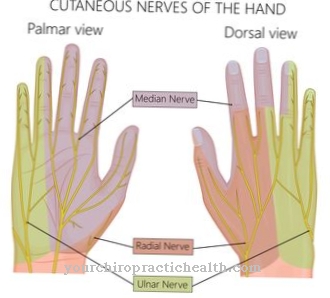In the diabetic neuropathy it is a disease of the nerves that can arise as part of a long-standing diabetes mellitus. The symptoms typically begin in the area of the feet and can manifest themselves with a loss of sensitivity and tingling, but also with symptoms of paralysis.
What is Diabetic Neuropathy?

© Reing - stock.adobe.com
Neuropathy is a disease of the nerves (more precisely the peripheral nerves, i.e. all nerves in the body with the exception of the brain and spinal cord), which can have various causes. Diabetic neuropathy is the typical nerve damage that can occur as a result of diabetes (diabetes mellitus).
Diabetic neuropathy occurs in around 30% of diabetics during their lifetime. This nerve damage can lead to a variety of complaints. Diabetic neuropathy typically manifests itself in a peripheral polyneuropathy in which many nerves are equally affected, and in an autonomic neuropathy, i.e. in a disease of the nerves of the involuntary nervous system.
causes
The exact factors behind the development of diabetic neuropathy are not yet well understood. The increased blood sugar level undoubtedly plays a decisive role in the development of diabetic neuropathy.
Neuropathy in diabetics with poor blood sugar control develops on average much faster than in well-controlled patients.
One factor that is held responsible for the destruction of nerve cells in diabetic neuropathy is the formation of sugar-protein compounds, which can arise at high blood sugar concentrations and have a direct damaging effect on the nerve cells.
Symptoms, ailments & signs
Diabetic neuropathy initially manifests itself through unspecific leg pain and abnormal sensations in the limbs. An increasing tingling sensation is typical, which is often associated with sensory disorders and numbness. In diabetic neuropathy, the legs are more sensitive to touch stimuli.
This often leads to a strange sensation when putting on socks or tights, which usually begins with the toes and radiates from there to the lower legs. Also characteristic are the small, mostly barely visible wounds on the foot, which enlarge in the course of the disease and can cause irreversible damage.
Furthermore, the disease can express itself as a feeling of malaise. The typical feeling of illness occurs mainly with chronic complaints. It manifests itself in pale skin, frequent sweats, and cardiovascular problems. The skin areas affected by the neuropathy also feel cold and often show a noticeable discoloration.
If diabetic neuropathy is not treated, serious secondary diseases can develop. Initially, there is a risk of vascular damage and embolism. It can lead to an insufficient supply of different organs, which can lead to further complications. In addition, there is an increased risk of infection in the affected areas on the leg, which can result in abscesses and ulcers.
Diagnosis & course
Often the diagnosis of diabetic neuropathy is only made when the patient has symptoms such as a tingling sensation in your feet.
The diagnosis can be made earlier, however, by specifically looking for symptoms of diabetic neuropathy in patients with diabetes. Peripheral polyneuropathy often first shows itself in a reduced sensitivity and temperature sensitivity, which typically initially affects the toes, feet and lower legs in the form of a stocking.
One possibility for early diagnosis is to use a tuning fork to check the vibration sensation at these points. The temperature sensation can also be checked by touching the foot with warm or cold objects.
The function of the nerves can also be examined more closely by examining the reflexes with a reflex hammer.A more detailed examination of the nerves is possible using electroneurography (ENG) and electromyography (EMG).
In the context of autonomic neuropathy, diabetic neuropathy leads to dysregulation of the cardiovascular system. B. in the long-term ECG and the so-called Schellong test, which consists of blood pressure measurements while lying down and after getting up show.
Complications
Diabetic neuropathy arises in the context of diabetes. The fact that the concentration of sugar in the blood is continuously increased, there are various complications. Sugar molecules can combine with proteins, which as a result can clog the smallest vessels, which leads to an insufficient supply of various organs.
An example of this are nerves (diabetic neuropathy), which can lead to sensitivity disorders and symptoms of paralysis. This is particularly the case on the foot. The affected person usually does not notice that there are minor wounds on the foot and does not pay attention to them. The wounds can enlarge over time and cause irreversible damage, as there are also wound healing disorders due to diabetes.
It also increases the risk of infection. This can cause the foot to die and, in the worst case, has to be amputated (diabetic foot). Furthermore, vessels in the retina are blocked, which can lead to impaired vision. In the worst cases, this can even lead to blindness (diabetic retinopathy).
Typically, diabetes leads to a disturbance of the kidney function, which can lead to complete failure (diabetic nephropathy). The quality of life is severely impaired and dialysis may have to be intervened or even a kidney transplant.
When should you go to the doctor?
If the person concerned suffers from sensitivity disorders, numbness or a tingling sensation on the skin, this is considered unusual. If the symptoms persist or if they increase in intensity and scope, a doctor must be consulted. If there are signs of paralysis, see a doctor as soon as possible.
In the case of painful legs or impaired locomotion, it is advisable to have a check-up. If there is hypersensitivity to the sensation of touching another person or clothing on the skin, there is cause for concern. A doctor should be consulted so that the cause of the inconvenience can be found.
If a changed perception of temperature influences develops in the toes, feet and lower legs, a doctor's visit is necessary. If you feel generally unwell or have a vague feeling that there are discrepancies, a doctor should be consulted. Symptoms can appear anywhere on the body, but the legs and feet are most likely to be affected.
A doctor should therefore be consulted as soon as possible, especially if there are irregularities in the limbs. If there is a feeling of ant walking on the skin or if the pain is boring or burning, an examination should be carried out as medical care is required. Some sufferers report a furry feeling, which is an indication for a doctor's visit.
Doctors & therapists in your area
Treatment & Therapy
An essential factor in the treatment of diabetic neuropathy is the consistent control of blood sugar levels in order to contain the progression of the disease.
Depending on the severity and type of the diabetes, this can be done through weight reduction, through tablets (so-called oral antidiabetic agents) or through insulin injections. Pain that can occur in the context of polyneuropathy can be treated symptomatically with painkillers.
So-called co-analgesics, which influence the perception of pain, also play a role here. B. antidepressants or anti-epileptics play an important role. Further therapy options include the administration of B vitamins (vitamins B1, B6 and B12) and fatty acids such as alpha-lipoic acid and gamma-linolenic acid.
Some of the consequences of autonomic neuropathy can be specifically treated. For example, diabetic neuropathy can lead to impotence, indigestion and an increase in blood pressure, all of which can be treated with specific drugs.
Outlook & forecast
Although diabetes is incurable, the prognosis for diabetic neuropathy is considered to be favorable in patients who suffer from diabetes for a short period of time.
The prognosis worsens in long-term patients. The lifespan is greatly shortened, especially in patients who have been suffering from diabetes for several years with an additional diabetic neuropathy. There are more and more disorders of kidney function and blindness can occur. The quality of life is reduced and the risk of developing a mental disorder is increased.
Patients who were diagnosed with diabetes only a few months ago have a good chance of relieving their symptoms with consistent lifestyle changes and good medical treatment.
The aim of treatment is to prevent the disease from progressing. With today's medical possibilities, this succeeds in almost all cases with these patients. If the blood sugar level is optimally adjusted and the patient lives healthy, there is an improvement in health. In addition to sufficient exercise and maintaining a normal weight, overexertion should be avoided.
The reduction of stress and the use of relaxation techniques to compensate for the daily challenges also help in coping with the disease. If the recommendations are followed, the patient can prevent further symptoms from occurring.
prevention
The best prevention for diabetic neuropathy is good treatment for diabetes mellitus. Early detection of diabetes also plays a role in this, in order to keep the time in which the patient has uncontrolled high blood sugar levels as short as possible.
In addition, alcohol should be avoided, especially when signs of neuropathy are beginning, as this can lead to additional damage to the nerves. A dreaded complication of diabetic neuropathy is diabetic foot syndrome: Due to the reduced sensitivity, small wounds on the foot occur more often, which heal more poorly due to the diabetes.
Often an amputation is required at the end. To prevent this, the feet should e.g. be examined with a mirror and consult a doctor quickly if there are problems.
Aftercare
Due to the chronic course of a diabetic disease, the patient should come regularly to the family doctor and to the appropriate specialists for control. Since diabetes mellitus often also affects the nerves, the patient should see a neurologist to check the function of the nerves and, if necessary, initiate treatment. The nerves are damaged to such an extent that numbness or muscle weakness develop.
The family doctor should therefore look at the foot during the consultation, as injuries are often overlooked by the patient due to nerve damage. In the worst case, amputation can be considered in the case of extensive damage to the foot (diabetic foot). In addition, the sugar should also be checked in order to control the setting of the medication and to initiate a change if necessary.
In the case of a newly discovered diabetes mellitus, the patient should be treated with medication and trained, as the intake can be very complex. In addition to the nerves, other organs are also frequently affected by diabetes mellitus. The patient should therefore also have an annual check-up by the ophthalmologist, who can use the fundus of the eye to detect a change in the retina that can lead to blindness.
In addition, a nephrologist should be consulted regularly, as damage to the kidney is not uncommon and can lead to kidney failure if diabetes mellitus is not set.
You can do that yourself
Diabetic neuropathy generally requires medical treatment. The diabetic can, however, also take action himself to protect himself from the consequences of the nerve disorder.
One of the most important measures is measuring blood sugar. This should be done in consultation with the doctor and at clearly defined times. The control of blood fat, body mass index (BMI), blood pressure and the circumference of the waist are also important. In addition, diabetics are advised to take good care of their nerves and avoid stress as much as possible. Avoiding nerve-damaging factors such as nicotine and alcohol is also advisable.
If the diabetic is overweight, it is recommended to lose it. A balanced diet and enough exercise help here. Anyone who wants to do sports despite diabetic neuropathy is well advised to speak to the doctor in advance to clarify the individual restrictions and options.
So the feet are not burdened to the same extent by every sport. The use of diabetic footwear or insoles also plays an important role. Daily control and care of the feet is just as important.
In addition, it makes sense for the diabetic to undergo regular preventive examinations and have them checked for possible nerve damage once a year. The focus is primarily on the feet.
Which measures are ultimately best suited to the individual should be discussed with the attending physician.



.jpg)






.jpg)

















